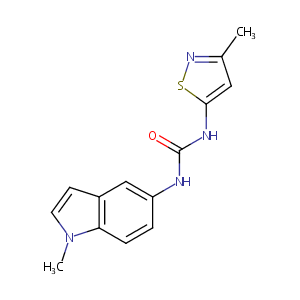| 1 |
URL: http://www.guidetopharmacology.org Nucleic Acids Res. 2015 Oct 12. pii: gkv1037. The IUPHAR/BPS Guide to PHARMACOLOGY in 2016: towards curated quantitative interactions between 1300 protein targets and 6000 ligands. (Ligand id: 221).
|
| 2 |
Pharmacological characterisation of the agonist radioligand binding site of 5-HT(2A), 5-HT(2B) and 5-HT(2C) receptors. Naunyn Schmiedebergs Arch Pharmacol. 2004 Aug;370(2):114-23.
|
| 3 |
Some properties of 5-hydroxytryptamine receptors in the hindquarters of the rat. Br J Pharmacol. 1979 Sep;67(1):79-85.
|
| 4 |
Privileged structures: a useful concept for the rational design of new lead drug candidates. Mini Rev Med Chem. 2007 Nov;7(11):1108-19.
|
| 5 |
New Insights into the Mechanism of Action of Viloxazine: Serotonin and Norepinephrine Modulating Properties. J Exp Pharmacol. 2020 Aug 25;12:285-300.
|
| 6 |
Prediction of Efficacy of Vabicaserin, a 5-HT2C Agonist, for the Treatment of Schizophrenia Using a Quantitative Systems Pharmacology Model.CPT Pharmacometrics Syst Pharmacol.2014 Apr 23;3:e111.
|
| 7 |
Emerging treatments for pulmonary arterial hypertension. Expert Opin Emerg Drugs. 2006 Nov;11(4):609-19.
|
| 8 |
Novel serotonin receptor 2 (5-HT2R) agonists and antagonists: a patent review (2004-2014).Expert Opin Ther Pat. 2016;26(1):89-106.
|
| 9 |
Anti-obesity drugs. Expert Opin Pharmacother. 2008 Jun;9(8):1339-50.
|
| 10 |
The inhibitory effects of tramadol on 5-hydroxytryptamine type 2C receptors expressed in Xenopus oocytes. Anesth Analg. 2004 May;98(5):1401-6, table of contents.
|
| 11 |
Inverse agonist and neutral antagonist actions of antidepressants at recombinant and native 5-hydroxytryptamine2C receptors: differential modulatio... Mol Pharmacol. 2008 Mar;73(3):748-57.
|
| 12 |
Serotonin 5-HT2C receptors as a target for the treatment of depressive and anxious states: focus on novel therapeutic strategies. Therapie. 2005 Sep-Oct;60(5):441-60.
|
| 13 |
Spinal serotonin receptor activation modulates the exercise ventilatory response with increased dead space in goats. Respir Physiol Neurobiol. 2008 May 31;161(3):230-8.
|
| 14 |
Clinical pipeline report, company report or official report of Jazz Pharmaceuticals.
|
| 15 |
Non-basic ligands for aminergic GPCRs: the discovery and development diaryl sulfones as selective, orally bioavailable 5-HT2A receptor antagonists ... Bioorg Med Chem Lett. 2010 Jun 15;20(12):3708-12.
|
| 16 |
SR46349-B, a 5-HT(2A/2C) receptor antagonist, potentiates haloperidol-induced dopamine release in rat medial prefrontal cortex and nucleus accumbens. Neuropsychopharmacology. 2002 Sep;27(3):430-41.
|
|
|
|
|
|
|


